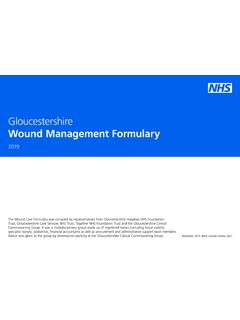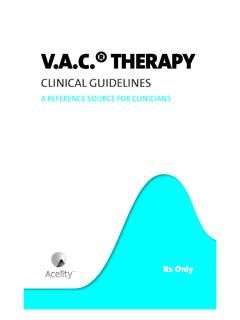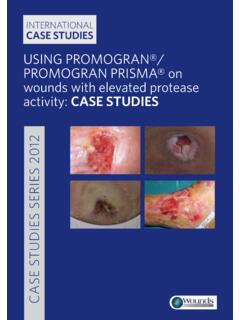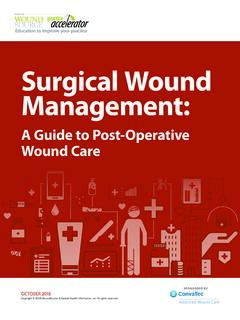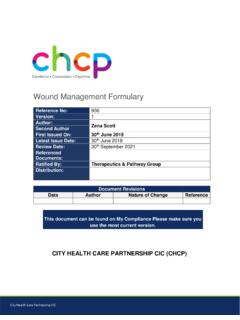Transcription of V.A.C. Therapy Patient Guide
1 TherapyPatient GuideAre you suffering from a wound ? | your doctor about Therapy and whether it may be right for of ContentsWound Healing is a Long Will it Take to Heal My wound ? ..2 What is Therapy ?..2 Four Part advanced wound Therapy System ..3 There is Only One Dressing Placement .. Dressing Changes ..5 Frequently Asked Questions about Healing is a ProcessProper wound care management is important to heal your wound and your doctor may prescribe the Therapy System for your care. A clinician is responsible for directing the use of the Therapy System including application and periodic dressing Long Will it Take to Heal My wound ?The length of time to heal a wound is different for every Patient . General conditions, size and location of the wound , and nutritional status can affect the time it takes for a wound to heal. Your clinician will discuss when and why Therapy may begin and is Therapy ?
2 Therapy is a medical device system that promotes wound healing by delivering negative pressure (a vacuum) to the wound through a patented dressing and Therapy unit creating an environment that promotes the wound healing process. This negative pressure helps draw wound edges together, remove wound fluids and infectious materials and promote granulation tissue formation (the connective tissue in healing wounds).Unlike gauze bandages that merely cover a wound , Therapy actively works to help the wound healing process. The Therapy System helps: Promote wound healing Provide a moist wound healing environment Draw wound edges together Remove fluid and infectious materials Reduce wound odor Reduce the need for daily dressing changes3 The Therapy System is an advanced wound Therapy System Consisting of Four Parts: The Therapy unit that delivers negative pressure Sterile plastic tubing with pressure sensing lumens that connect the Therapy unit to the dressing Special foam dressings ( GranuFoam and WhiteFoam dressings ) that are placed in the wound A clear drape with adhesive ( Drape) that covers the foam dressing(s) Therapy tubingDevice illustration representative only.
3 Your doctor may prescribe a different Therapy unit. GranuFoam GranuFoam Dressing*There is Only One TherapyKCI commercialized the world s first negative pressure wound Therapy (NPWT) system, Therapy , and is a market leader in advanced wound Therapy . With more published clinical evidence than any other form of NPWT, Therapy has been selected as the treatment of choice for more than 8 million wounds worldwide. Many clinicians, hospitals, skilled nursing facilities, wound care centers and home health agencies use or prescribe the advanced Therapy System to help their patients are other NPWT systems, but utilizing a proprietary NPWT pump, advanced software and pressure regulating technology ( ) and a diverse foam dressing portfolio, Therapy is the original and most widely prescribed NPWT treatment in the world. Dressing PlacementThe Dressing goes on or inside a wound .
4 One end of the tubing connects to the dressing. The other end connects to the canister that fits into the Therapy unit. The wound area is sealed with the clear Drape with adhesive that helps maintain negative pressure over the wound .*If used, the WhiteFoam Dressing is typically recommended for placement under the GranuFoam Dressing ChangesThe Therapy System uses proprietary foam dressings ( GranuFoam and/or WhiteFoam) with the Therapy unit. Only dressings are to be used with the Therapy Units. Wounds treated with the Therapy System should be monitored on a regular basis by your clinicians who are responsible for treatment. For a non-infected wound : KCI recommends the dressings be changed every 48 to 72 hours, but no less than 3 times per week. For infected wounds: These wounds must be monitored often and very closely. Infected wounds dressing changes may need to be changed more often than 48 to 72 hours.
5 Dressing change intervals should be based on continuing evaluation of your wound condition by your : The Therapy System is indicated for patients with chronic, acute, traumatic and dehisced wounds, partial-thickness burns, ulcers (such as diabetic, venous leg, or pressure), and flaps and grafts. When used on closed surgical incisions, Therapy is intended to manage the envi-ronment of surgical incisions that continue to drain following sutured or stapled closure by maintaining a closed environment and removing exudates via the application of negative pressure wound Therapy . Therapy is contraindicated for patients with malignancy in the wound , untreated osteomyelitis, non-enteric and unexplored fistulas, necrotic tissue with eschar present and sensitivity to silver ( GranuFoam Silver Dressing only). Do not place Foam dressings in contact with exposed blood vessels, anastomotic sites, organs, nerves.
6 Please discuss and review this information and the device instructions for use with your clinician so you can fully understand the benefits and risks of frequently asked questions about Therapy1. How does Therapy feel?Most patients describe Therapy as a non-painful, mild pulling sensation that, in most cases, is not noticeable after a few minutes. wound comfort may vary by individual. The wound may become tender or itch as it heals; this is usually a good sign. If itching or discomfort persists, please contact your Can you move around while on Therapy ?Your ability to move around depends on your condition, the wound location and type of Therapy unit prescribed. The Therapy System may be disconnected so you can take a shower. Therapy may not be off any longer than two hours per What does the foam dressing look like when Therapy is working?Your doctor may prescribe a GranuFoam or WhiteFoam Dressing for your wound type.
7 The GranuFoam Dressing will shrink down and wrinkle like a raisin when Therapy is working. The WhiteFoam Dressing may only have a few wrinkles. 4. Does changing the Dressing hurt? Some people do experience discomfort during dressing changes depending on the wound type, location and Patient condition. The discomfort is similar to other dressings and wound care treatments for the same wound type. Your doctor or nurse can give you advice about pain Who should change my dressing? Usually a nurse from your doctor s office, home health agency or wound care clinic trained in Therapy , will change your dressing. If deemed appropriate by your doctor or nurse, a caregiver, family member or friend may change the dressing if they have been properly trained. To help stop the spread of germs and infection, cover your mouth and nose with a tissue when you cough or sneeze and put your used tissue in a waste basket, or cough or sneeze into your upper sleeve, not your hands.
8 The following steps should be followed by you and/or your caregiver to reduce the risk of infection: Caregiver should wash hands with soap and warm water for 20 seconds or clean hands with an alcohol-based hand cleaner, before and after each Patient contact or procedure. Caregiver should always wear gloves and protective clothing and eyewear when handling blood or body fluid, or when in contact with mucous membranes or open cuts. Any caregiver with an open cut or skin condition should not care for the Patient until the condition has been cleared. Caregiver should dispose of soiled dressing according to hospital or institution protocols. Do not reuse dressing. Caregiver should always note the total number of pieces of foam used in the wound and document on the Foam Quantity Label (if supplied) and in the Patient s chart. Refer to application instructions provided with the When should I call my clinician when on Therapy ?
9 Immediately report to your clinician if you have any of these symptoms: Fever over 102 Diarrhea Headache Sore throat Confusion Sick to your stomach or throwing up Dizziness or feel faint when you stand up Redness around the wound Skin itches or rash present wound is sore, red or swollen Pus or bad smell from the wound Area in or around wound feels very warm7. What happens if the Therapy System alarms?The Therapy System is built with your safety in mind. The Therapy unit has alarms that you can see and hear which will alert you to a potential problem. In most situations, the reason for the alarm is easily fixed. This is something your clinician can explain in more detail, so you are comfortable with this alarm How noisy is the Therapy System?All of the Therapy Systems are medical devices with moving parts. Noise may seem louder at night when surrounding noise level is greatly decreased.
10 The units are designed with software that help to identify leaks at the wound site. When a leak is present, the unit may make a ramping noise and the unit will begin to alarm. When the seal has been fixed, the unit will no longer alarm and the ramping noise will stop. The unit may also have a gurgling sound when clearing air from the Who should I contact if I have further questions?Contact your clinician with any medical questions. In case of an emergency immediately call your local emergency contact number ( 911). Once Therapy is prescribed, for questions about Therapy System operation, call 1-800-275-4524. This is a summary of some basic information about Therapy . It is not intended to be a Guide to product use, operation and placement. Please read the Therapy System Quick Reference Guide and Therapy System User Manual for specific questions and important information about Therapy System indications, contraindications, warnings, precautions and operation and discuss this information with your : Federal law restricts this device to sale/rental by or on the order of a physician.

